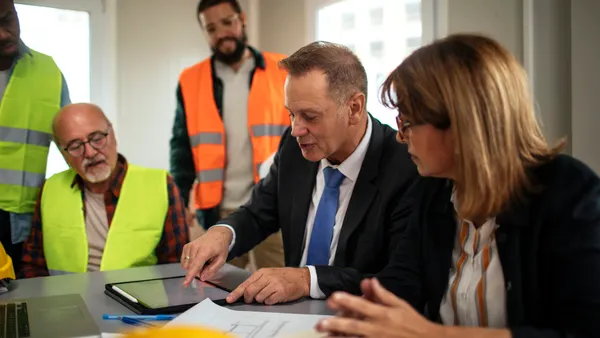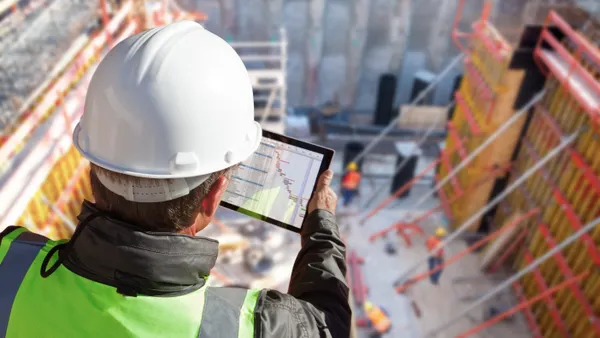Technology provides great tools for designing a new home or renovated space and even viewing it in a virtual environment, but there is still a big question left on the table: At the end of the day, how much is it going to cost to build?
Virtual 3D Material Take-offs simplify the process of estimating. In this more visual process - you can also see what you are estimating in real time.
In this article we will explore the process of doing a virtual residential take-off, give examples of how it works and finish with the benefits of estimating in a visual 3D environment.


Generally, the information about the home arrives in one of three ways for the take-off:
- First, the builder may also be the designer, in which case they can use the original file, like an Envisioneer™ design file, to generate the estimate.
- Second, a PDF of the floor plan and elevation is provided.
- Or third, it may be a hand drawing arriving in paper format.
Starting a Virtual Estimate with a PDF or DWG file
If the original design file is a pdf, dwg or dxf file it can be used directly in programs like Envisioneer™ for a virtual take-off. Using that original file provides a solid starting point.
During the import procedure there are tools available to ensure accuracy and simplify the information used for the estimate. For example, you can double check the scale used by the designer for accuracy. Estimating using a 1/4-inch scale listed on a drawing sheet when it actually should be 1/8 inch can be a very costly oversight!
You can also crop just the areas that need estimating and rotate to any angle that works best for you. Once these initial steps are completed, the estimating work can begin. These initial steps ensure that what you are basing your material report on is as accurate and useful as possible.

Selecting Building Materials to Estimate
Now select specific elements to take-off. It's as simple as tracing around exterior and interior walls in the pdf and it simultaneously calculates the finish, framing materials and even gallons of paint required to build the wall.
Pick windows, doors and openings to insert and not only do they get included in the material take-off, but they also frame around the opening. The process is like the manual hand method of measuring and highlighting a printed blue print, but this way it virtually builds and frames the walls, calculates the linear feet of trim, and reports back any finish materials and fasteners all at the same time.

Detailed formulas are used to drill down to extremely accurate and efficient estimates for materials like drywall tape, where factors like linear footage play a big part in the estimate. Waste factors can also be added to the formula for each building element, further enhancing the accuracy of the estimates. You have access to the formulas, so you can refine them to match your usage on site.

If the original design was done by hand and all you have is the printed working drawing sheets, you can use the same tools, but instead of tracing the walls you can type in the measurements of each wall as you indicate which direction it is going. Envisioneer™ will build the walls to match your input. Same estimated values just a different input method.
You want to ensure that your estimating tool is flexible to allow for many different input methods depending on the information that you receive.
The Material Report
At the end you have an estimate of the materials that can be organized into different headings and printed or exported into a variety of formats.
For building supply centers this means they can link the data to the POS, the heartbeat of their business. For builders using Excel or a construction management software the information can be shared and used for scheduling purposes. Or simply print it out to order the products or use it for your quote.

While there are countless obvious benefits to generating virtual estimates, here are few of the most important ones:
- Using 3D views will help ensure you aren't forgetting anything. The ability to constantly check the model to see how materials are being used will make sure the numbers you’re pulling are correct, helping to avoid costly mistakes.
- Documents can be provided directly to the builder to show exactly how the materials are being used, allowing for more efficient material management on the job sites.
- Seeing a 3D rendering of what each element of the home should like after it’s built helps ensure that each piece of material is being used appropriately.
- Each wall can be printed as an individual wall framing panel diagram that labels each board used.
- Ultimately, using the Envisioneer™ technology to generate virtual estimates saves time (and time is money). By using the same model that was used for the design, there’s no need to redraw anything or recalculate materials. One model becomes the one-stop-shop for any data you might need. Here are some added bonuses to using a virtual estimate system like Envisioneer™;
- Automatic Presentation Drawings (Renderings and VR environment)
- Automatic Permit Drawings
- Sharing information through links to;
- Energy Audit software applications
- Point Of Sale (POS) systems
- Construction Management software
- Manufacturing software (MiTek™,Weyerhauser™,Boise™, Keymark™)
- 2020™ Kitchen Design software
Be it track housing or custom homes or a renovation project, the convenience and accuracy of using virtual estimation allows builders and building supply centers to organize their shipments and builds into one very accurate process. This, in turn, boosts accuracy and efficiency, both of which will translate to faster builds and higher profits.
For more information visit www.cadsoft.com and download a trial to test drive it yourself!









